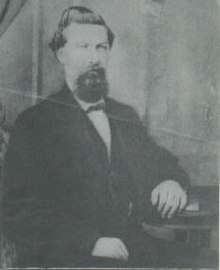Phil Coe
Phil Coe (July 13, 1839 Gonzales, Texas – October 9, 1871 Abilene, Kansas), was a soldier, Old West gambler, and businessman from Texas.[1] He became the business partner of gunfighter Ben Thompson in Abilene, Kansas, with whom opened the Bull's Head Saloon.[2] He was killed by marshal Wild Bill Hickok in a street brawl.
Phil Coe | |
|---|---|
 | |
| Personal details | |
| Born | Philio Houston Coe July 13, 1839 Gonzales, Texas, United States |
| Died | October 9, 1871 (aged 32) Abilene, Kansas, United States |
| Nationality | American |
| Mother | Elizabeth Parker Coe |
| Father | Phillp Haddox |
| Occupation | Soldier, gambler and businessman |
| Military service | |
| Allegiance | Confederate Army |
| Commands |
|
| Battles/wars |
|
Early life
Phillip Houston Coe was born in 1839 to Phillp Haddox and Elizabeth (Parker) Coe, in Gonzales, Texas, one of the earliest settlements west of the Colorado River.
Military career
In March 1862, during the American Civil War, Coe at age 23 enlisted in the 36th Texas Cavalry Regiment, Confederate Army. He later served in the 2nd Texas Cavalry Regiment, ending his army service in April 1863. He is said to have served next in Mexico under Emperor Maximilian.
Post-war
After the war, Coe drifted through Texas, becoming friends with gunfighter Bill Longley, and learning to gamble from gunman Ben Thompson, whom he had served with in Mexico. He then settled in Salina, Kansas, where he became a saloon owner and talented gambler. In May 1871, Coe became Ben Thompson's business partner in Abilene, managing the popular Bull's Head Saloon. They decorated it with a large symbol of masculinity which offended the citizens of Abilene. He got to know many of the Old West's leading figures, including John Wesley Hardin and Abilene's town marshal, Wild Bill Hickok.
Coe took an immediate dislike to Hickok, while Ben Thompson usually got along with him, the men respecting each other's reputation as a gunfighter. Coe and Hickok had words on several occasions. Once, Coe was bragging about his marksmanship, claiming he could "kill a crow on the wing". Hickok allegedly remarked, "Did the crow have a pistol? Was he shooting back? I will be."[3] That only increased their enmity even more.
On October 5, 1871, Hickok stood off a crowd alone following a street brawl. Phil Coe was in the crowd and shot twice at Hickok, missing him both times. Hickok fired back, seriously wounding Coe. However, Hickok also mistakenly shot and killed his deputy, Mike Williams, who was running to his aid.[4][5] Williams was due to return to Kansas City that night.[6] This fatal accident haunted Hickok for the rest of his life.
Phil Coe lingered for several days, before dying on October 9, 1871. He would be Hickok's last known killing. Coe's body was taken to Brenham, Texas, where he had relatives. He was buried there in Prairie Lea Cemetery.[3]
References
- Weiser, Kathy (September 2017). "Phil Coe – Gunfighter and Gambler". Legends of America. Retrieved December 27, 2017.
- Keys, Jim (January 28, 2013). "Wild Bill Hickok". The History Herald: 2. Retrieved December 27, 2017.
- Parsons, Chuck (June 12, 2010). "Coe, Philip Houston". Texas Handbook of History Online. Retrieved August 30, 2010.
- "Special Deputy Marshall Mike Williams". Officer Down Memorial Page. Retrieved August 30, 2010.
- Trimble, Marshall (March 1, 2006). "Was Mike Williams an Abilene, Kansas, deputy at the time of the gunfight between Wild Bill Hickok and Phil Coe?". True West Magazine. Calhan, Colorado. Retrieved December 27, 2017.
- Trimble, Marshall (March 12, 2012). "Who was the man Wild Bill Hickok shot and killed in Abilene, Kansas?". True West Magazine. Salem, Oregon. Retrieved December 27, 2017.
Bibliography
- Parsons, Chuck (1984). Phil Coe, Texas Gambler. Wolfe City, Texas: Henington Publishing Company. p. 40.
- Rosa, Joseph G. (1964). They Called Him Wild Bill: The Life and Adventures of James Butler Hickok. Norman: University of Oklahoma Press. pp. 278.
- Streeter, Floyd Benjamin (1957). Ben Thompson. New York: Fell.
- Walton, W. M. (1884). The Life and Adventures of Ben Thompson: The Famous Texan. Austin: Steck. p. 420.